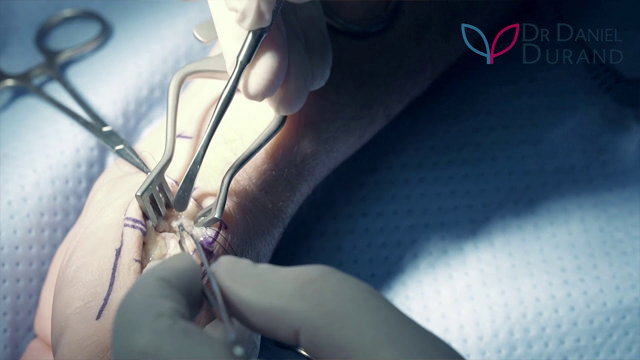



Trapeziometacarpal joint arthroplasty of the thumb
If you have symptoms of Thumb basal joint arthritis, Dr. Durand offers effective treatments to release your condition.
PROCEDURE
Thumb arthroplasty is a surgical procedure to treat arthritis affecting the joint at the base of the thumb.
Thumb arthritis is a type of osteoarthritis found at the carpometacarpal joint located at the base of the thumb. The carpometacarpal joint gives the thumb a wide range of motion – up, down, and across the palm, as well the ability to pinch.
Arthroplasty helps restore mobility and function to the thumb. Thumb arthritis may be initially treated non-surgically. However, because arthritis is a progressive condition, the symptoms of pain, swelling and loss of function gradually become worse and non surgical options may no longer work. This is when thumb arthroplasty surgery is indicated.

Conditions treated:
HOW IS IT DONE
Thumb carpometacarpal arthroplasty involves removing the small wrist bone that is part of the carpometacarpal joint and replacing it with a wrist flexor tendon.
During the procedure, a small incision (approximately 1.5 inches) is made over the carpometacarpal joint, and the trapezium wrist bone is removed.
A small incision is then made in the forearm to release a wrist flexor tendon. First it is attached to the base of the thumb metacarpal bone with a bone anchor, and then the remainder of the tendon is rolled into a ball and placed into the void left by the trapezium. This creates a cushion between the remaining bones.
The incisions are closed with absorbable sutures, and the hand is covered by dressing and cast to immobilize the wrist and a portion of the thumb.
IF YOU ARE CONSIDERING TREATMENT FOR A THUMB BASAL ARTHRITIS, DR. DANIEL DURAND WILL GUIDE YOU, FROM CONSULTATION TO RECOVERY, TO THE BEST THUMB ARTHRITIS PROCEDURES FOR YOUR INDIVIDUAL NEEDS.
POSSIBLE COMPLICATIONS
As with any surgery, thumb arthroplasty can cause infection. You may experience an allergic reaction to the anesthesia used in the removal, or to the stitches used to seal the removal site. Other possible risks include:
- sensitivity around scar tissue
- injuries to surrounding tendons, nerves, or ligaments
- losing the ability to move the thumb normally
Most likely, you’ll heal quickly and without difficulty after a thumb arthroplasty.
RESULTS
Though you will be able to start using your hand and thumb six weeks after surgery, it can take up to six months to one year for the thumb to feel normal, and strength will continue to improve over several years. Long-term studies do not show any functional deficits with using the forearm flexor tendon, as there are other tendons that do the same job.
CONTACT US ONLINE TODAY TO LEARN MORE ABOUT TRAPEZIOMETACARPAL ARTHROPLASTY.
DR. DANIEL DURAND HELPS MEN AND WOMEN FROM MONTREAL AREA TO ENJOY A PAIN-FREE LIFE AGAIN THROUGH THIS PROCEDURE.





